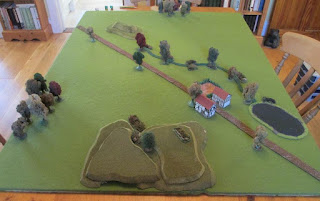Here is the second of my 15mm battles, this time between the Elector Palatine's forces and those of Austria, fighting over Bohemia. The Elector's forces won the battle, their infantry outfighting those of the Emperor, although their cavalry did not do quite as well. The Austrians had to fall back and Bohemia remained in the Elector's hands.
The battlefield. I am generating these randomly and in this case, the terrain is rather more crowded than the average Thirty Years' War battle. The hills are rated steep and only infantry can cross them; the stream can be passed by foot and horse, but not artillery. The woods are passable only to infantry.
The opposing forces deployed for action: on the left of the picture is the Palatine army,
on the right the Austrian army.
The Palatine army ended up spilt into a cavalry wing and an infantry and artillery wing, which the Austrians mirrored, with the latter deciding not to defend the village.
Each side can deploy up to 30cm/12 inches in from their own edge. All units have to be under a commander, except dragoons and artillery, or those designated as a reserve. Cavalry and infantry cannot mix within a command.
The Austrian cavalry wing of two brigades.
The Austrian infantry in two brigades, with their artillery and dismounted dragoons beyond the stream.
Some of the Palatine infantry; the cuirassiers at the rear were designated as a reserve.
More Palatine troops. The unit at the rear is Commanded Shot Battalion, i.e. all muskets, no pike. Commanders can only influence the units under their command, giving bonuses for combat and complex manoeuvres if attached to a unit.
The counters (red, black and white) show varying levels of combat effect on units, from "formed", through "unsteady" to "disordered". The final stage is "broken", when the unit is removed from the battlefield.
The cavalry battle was a see-saw encounter of charge and counter-charge which, owing to the confined space, meant it was difficult to get many units engaged or to manoeuvre on a flank. In the end, the second Austrian cavalry brigade watched out the battle unengaged.
The Austrian dragoons and artillery fought gallantly but were no match in the end for the Electoral foot.
Mounted units can use their carbines/pistols, the Elector's cavalry on the right firing at their charging Austrian opponents, which is a disadvantage as they count stationary, but might cause losses to the attackers as they charge home.
By this stage in the battle, the Electoral infantry had secured the village and overrun both the Austrian battery and their dragoons, while in the centre they had beaten off the Austrian infantry's attack across the stream quite successfully. The cavalry fight was still continuing, although the Emperor's horse were gradually pushing back those of the Elector.
The Austrian infantry unit at the lower part of the picture eventually surrendered, being threatened with a flank charge from the cuirassiers and enfilade fire from the Commanded Shot Battalion.
The closing situation of the battle. Each game lasts 12 turns in Spring/Autumn campaign turns (as in this case) or 15 turns in Summer campaign turns. Having lost the infantry battle and with the cavalry action still undecided, the Austrian commander decided to accept defeat and withdraw.
The Elector Palatine's army had:
One
Cuirassier Squadron
Eight
Horse Squadrons
One
Dragoon Squadron
Four
Foot Regiments
One Commanded Shot Battalion
One
Medium Gun Battery
Four
Generals (Two Mounted, Two Foot)
The Austrian army had:
One
Cuirassier Squadron
Eight
Horse Squadrons
One
Dragoon Squadron
Four
Foot Regiments
One
Medium Gun Battery
Four
Generals (Two Mounted, Two Foot)




























Always nice to see a game with so much cavalry.
ReplyDeleteI think it's one of the good things about 17th century games, especially 30YW and Sun King Wars, where cavalry formed such a high proportion of armies, sometimes 50%. I can't imagine many late 18th century of 19th century battles where the cavalry comes anywhere near that quantity, maybe 25% maximum? I think it must be one of the "Great Sights" of the past now lost to us, 10,000 or more horsemen manoeuvring on a battlefield, the sounds and the noise and the odour!
Delete